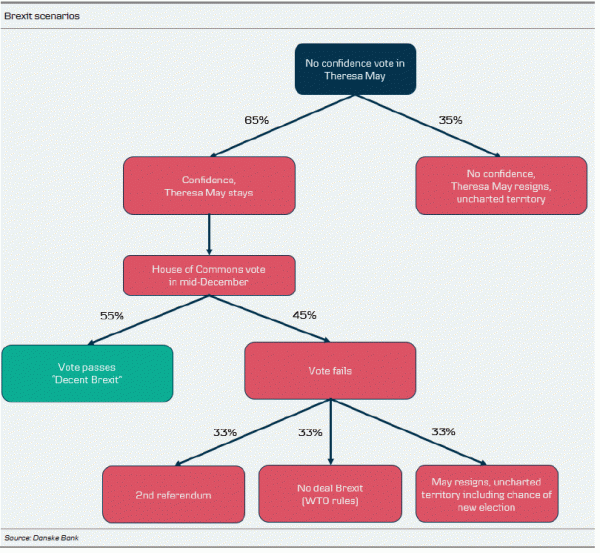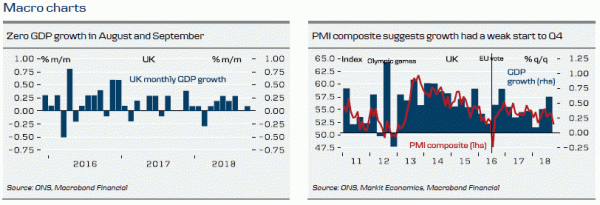Key dates
- Very near term: Will there be a no-confidence vote in Theresa May? If the threshold of 48 letters is triggered, the vote may come very quickly.
- 25 November: Extraordinary EU summit on Brexit. Deal due to be signed.
- Mid-December (10 December has been reported): Vote on Brexit agreement in House of Commons.
- 13-14 December: EU summit.
- 20 December to 7 January: House of Commons recess due to Christmas.
In the very short term, we think it is important to keep an eye on two things.
- Will the DUP continue to support the government? Media reported (see Reuters) yesterday that the DUP is considering pulling its support for the government unless the Conservatives replace Theresa May as party leader. The DUP later denied this but, in our view, the genie is out of the bottle now and it is factor to look out for.
- Will there be a Conservative leadership challenge? The threshold of 48 letters to trigger a leadership challenge has not been reached yet but 20 Conservatives have stated publicly that they have sent a no-confidence letter. It is possible that some have sent a letter without saying so. We still think it is likely there will be a confidence vote.
Based on developments this week, we have updated our Brexit ‘game tree’ (see overleaf). The first and most imminent issue is whether Theresa May will survive a possible leadership challenge. As we have argued for a long time, we think the hardliners are enough to trigger Theresa May but not enough to topple her. However, the risk is that if the hardliners get some tailwind more MPs will follow suit as politicians like to be part of the winning team. We think the probability of Theresa May winning a confidence vote is 65%. If she loses, she would have to resign and we would be in uncharted territory where many outcomes would be up in the air. It is difficult to say who would succeed May and the process may take as long as two months. This would probably mean the EU has to extend Article 50.
Assuming Theresa May wins the confidence vote (or the threshold is never reached), we think the EU leaders will accept the deal on Sunday 25 November and a vote on the deal is expected in the House of Commons in mid-December (10 December has been reported). As said before, the vote in the House of Commons is the real test. While it is likely the vote would be very close, we are still leaning towards May being able to get the deal through despite the hardliners, the DUP, the Labour leadership, the Liberal Democrats and the Scottish National Party all saying no. The reason is that it is easier to say that you are against the deal than to vote it down. Some of the less-prominent Brexiteers will fear that voting no to the deal means Brexit could be reversed. Moderates are likely to fear that voting against the deal would mean the UK crashing out in a ‘no-deal’ Brexit. We think the probability of the deal passing the House of Commons is 55% and we will end up in our ‘decent Brexit’ scenario.
There is a risk is we are being naïve here and the stakes are high for everyone. A 45% probability is also non-negligible. If the deal is voted down, we see three possible scenarios here and it is difficult to say which one is the most likely. We think May would have to step down, increasing political uncertainty and meaning we are in uncharted territory. While we cannot rule out a new general election, we think it is unlikely given it would require a super-majority in the House of Commons, which is difficult to see given many Conservatives would fear losing their mandate to Labour. We think it is equally likely that the politicians will call for a second referendum, or that the UK simply just crashes out of the EU.
We discuss what it means for GBP in FX Strategy – Brexit scenarios and outcomes for EUR/GBP, 16 November.



















